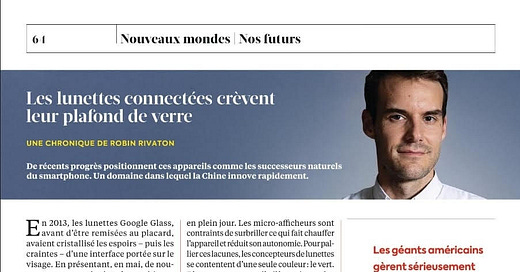Smart Glasses: Breaking Through the Glass Ceiling
Les lunettes connectées crèvent le plafond de verre - L'Express 12 juin 2025
In 2013 Google Glass embodied both the hopes and the fears of a face-worn interface before fading from view. Twelve years later, at its I/O developer conference on 20 May 2025, Google unveiled fresh prototypes, signalling that the bet is very much alive. The hint had come in March, when Google paid US $115 million for Canadian eye-tracking start-up AdHawk Microsystems. Across the industry, every player wants a pair of glasses to become the natural heir to the smartphone. That means true augmented-reality optics that leave the real world visible while floating graphics in front of it—nothing like a VR headset that seals you off.
Electronics have leapt ahead—low-power chips, pin-head cameras, dense batteries—yet optics remain the stubborn bottleneck. In most AR glasses the image starts in a micro-display, enters a waveguide etched into the lens and exits in front of the eye; as much as 97 % of the original luminance is lost along the way, a problem that gets worse in daylight. To stay legible, the display has to blast out extra brightness, which means heat and ruthless power drain.
Designers work around the limitation by using a single colour—green. Photopic sensitivity of the human eye peaks at around 555 nm, right in the green band, so a green glyph looks far brighter than a red or blue one for the same luminous flux. A full-colour display would need either three side-by-side sub-pixels or a colour-conversion layer plus waveguide corrections, whereas a green-only stack can get by with a single, thinner diffractive layer that is clearer and easier to cut to lens shape.
Today’s AR glasses deliver roughly 300–500 nits at the eye—1 nit equals 1 candela per square metre—while outdoor readability calls for 1 300–1 500 nits.
While Silicon Valley polishes prototypes, a swarm of Chinese start-ups—the so-called “Five Little Dragons” (Xreal, Rokid, RayNeo/TCL, Inmo, Mad Gaze)—is shipping product after product, experimenting with tethered smartphone compute, neck-loop battery packs and every price–feature trade-off it can find. Prices run from about US $300 to US $800. TCL’s RayNeo X2, launched two months ago, advertises 1 000 nits thanks to micro-LED-on-silicon (LEDoS) technology, the same approach Meta showed in its Orion prototype back in September 2024. The frenzy is fed by a local supply chain: Shanghai-based Jade Bird Display, founded in 2015, already supplies Meta with its micro-LEDs.
In the United States the race is led by Meta, Google and Apple—though Apple has yet to ship anything. Meta has extended its exclusive deal with EssilorLuxottica for Ray-Ban frames until 2034, aiming to blend style with connected services while baking a real display into the temples. Following a similar script, Google has pledged US $150 million to consumer eyewear maker Warby Parker to co-develop AI-powered Android XR glasses.
One entry barrier the Silicon Valley giants are counting on against fast-moving Chinese rivals is vision correction. The World Health Organization puts the number of people with near- or far-sightedness at 2.2 billion. At the end of 2022 Meta bought Belgian-Dutch firm Luxexcel, whose 3-D-printing process can produce a single prescription lens with an integrated waveguide. Another Eindhoven spin-off, AddOptics, announced a custom lens onto which Lumus waveguides are bonded. For the moment, Europe’s role in smart glasses looks less like a launch pad and more like a research lab.




